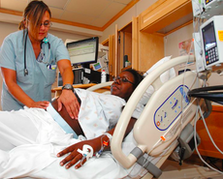 This New Year's Eve we welcomed 2022 with a cozy practice and some inspiring words, here are all the readings from our workshop: "Our true home is in the present moment. To live in the present moment is a miracle. The miracle is not to walk on water. The miracle is to walk on the green Earth in the present moment, to appreciate the peace and beauty that are available now. Peace is all around us in the world and in nature, and within us; It is in our bodies and our spirits. Once we learn to touch this peace, we will be healed and transformed. It is not a matter of faith, it is a matter of practice." -Thich Naht Hanh
2 Comments
 It can be incredibly important when experiencing hip pain to incorporate strengthening as well as stretching. Often times when muscles aren't being used effectively, we will feel soreness as smaller supporting muscles step up to bat (and fail pretty quickly). During pregnancy, with the increased weight of baby as they grow and the added strain on joints due to relaxin, hips are often the number one complaint. But remember, if hips are aching, try strengthening them first! Most of the time this will help to alleviate some of the discomfort you feel. Add these five practices to your daily routine (or pick one or two to make it easy!) and begin to notice a huge difference in the hip pain you are experiencing (or visit our online yoga pregnancy yoga classes for practices to help the hips):  Generally for most folks pubic pain shows up in the third trimester, though if you had it in your previous pregnancy, chances are good it will show up again (and earlier) in your following pregnancies. For most people this shows up as a sharp, shooting pain in the region of the pubic bone. The interesting thing about the pubic bone is its actually a joint, there are two bones that meet at what we think of as the pubic bone, and like any joint, there is connective tissue that holds the joint together. Because of relaxin, a hormone released during pregnancy, connective tissue in the body is softening over time. As baby grows, added weight presses down on the pelvis which puts strain on this joint, and for some folks this ends up causing pubic symphysis dysfunction. It will usually show up one of two ways 1) when doing lunges or after long walks or exercise where legs are going forward and back or 2) when opening the knees away from one another in things like rolling over in bed.  This is Part IV of a four part series on how yoga can support you doing labor and childbirth. Haven't read the first parts? Go back and visit, Part I, Part II and Part III. As I mentioned in previous posts, there’s no magic yoga pose that you can do in labor that will make things easier or less painful, but what you can do is yoga poses during pregnancy that will help better prepare your body for labor. I know I’ve mentioned it before, but think of it this way: you wouldn’t go out and run a marathon one day with no prior training, labor is the same thing. Yoga poses can help build strength and create opening in areas that will be post impacted by labor and childbirth. Here are the places of focus that yoga poses can help with to prepare your body for birth:  This is Part II of a four part series on how yoga can support you doing labor and childbirth. In the first and second parts we discussed how yoga can help connect you to your breath and your strength Haven't read them yet? Be sure to check it out Part I and Part II. Relaxation and labor seem to be polar opposites right? The trick with labor is that there are moments of relaxation, even in active labor. Between each contraction there is always a resting period. We might think about contractions as a wave that rise, peak and then ebb. Following the ebbing of a contraction is an opportunity to rest. The closer contractions get to one another, the shorter this rest period is, but taking advantage of these rest periods can make a world of difference in labor, particularly in longer labors.  This is Part II of a three part series on how yoga can support you doing labor and childbirth. In the first part we discussed how yoga can help connect you to your breath. Haven't read it yet? Be sure to check it out here. Our own strength can surprise us sometimes, and nowhere more so than in childbirth. However, it often takes our yoga practice to help us understand that strength and how we can push through something even when it is physically demanding or difficult. Here are some ways that yoga can help us explore how strong we are as we prepare for the physically demanding reality of birth:  Yoga is amazingly helpful and effect to help address so many of the aches and pains of pregnancy and also offers a powerful time for you to connect with your ever-changing body and bring balance to energy and emotions during this roller coaster ride. People often look to yoga to help support them during birth as well. The thing is there is no magic yoga pose that will be helpful in birth, but what yoga can help you do is learn how powerful your body is, strengthen your body in preparation for the physical needs of birth and help you connect to your breath which is the one thing you will have with you as a tool throughout your entire birth. Here's Part I of a four part series on how yoga can support you during birth...  We may think this fun little side effect of pregnancy wouldn’t show up until the third trimester when baby is taking up a great deal of space in the abdomen and pressing on the internal organs, but for many folks, it shows up right away in the first trimester. Increased levels of progesterone slow down the soft muscle contractions of the intestines, which slows digestion so more nutrients can be absorbed. When food moves more slowly through the digestive tract, constipation and gas are natural side effects.  Every few months I teach a Partner Yoga for Birth workshop that helps pregnant folks and their partners explore how yoga and breath can help prepare for labor and also ways they can explore together what support looks like during labor. With restrictions in place on the number of support people currently allowed at hospital births, many folks have been inquiring about how to better prepare their birth partners for supporting them in their labor. Here are some key takeaways from that workshop that will hopefully be of service to you and to them.  This one is another doozy that new parents are often unprepared for in terms of bodily discomfort. We often don’t think about the fact that holding baby for an extended period of time can cause forearm tightness and compression in wrist joints. The combination of these two things can lead to inflammation of the tendons running through the carpal tunnel and out to the hands and fingers. As a result, folks often have debilitating wrist, hand and finger pain that is hard to manage because they can’t stop holding their babies, so it is difficult to mitigate the inflammation. Especially with new parents who may not feel completely at ease holding their new baby, there is a tendency to want to curl in and hold the baby extra tight. What often happens is they curl their hands in and around the head or the baby’s bottom creating extra pressure on the wrist joint. |
AuthorYoga teacher, sound healer and explorer of the inner landscape. Join me! Archives
December 2021
Categories
All
|
 RSS Feed
RSS Feed